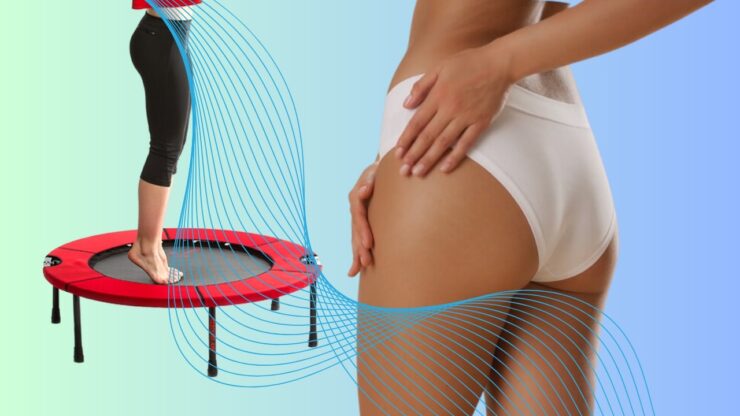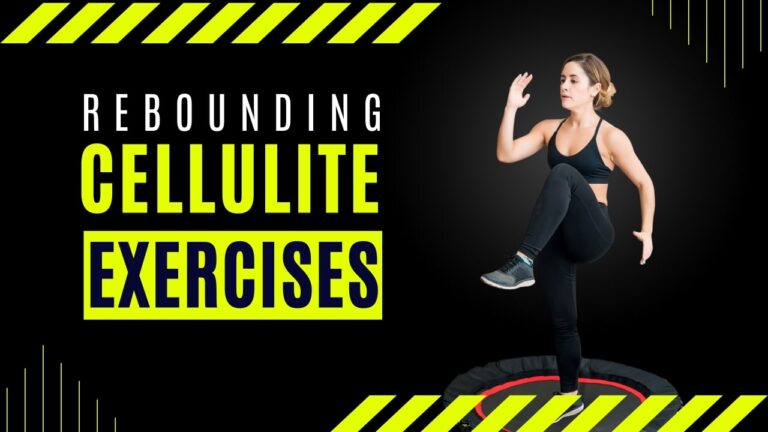Cellulite, those dimply areas of skin that can appear on the thighs, hips, buttocks, and abdomen, is a common aesthetic concern among individuals, predominantly women, worldwide. But have you ever considered that the simple childhood joy of bouncing on a trampoline could serve as a potent strategy against this notorious beauty culprit? This blog post will delve deep into the phenomenon of ‘rebounding’—the act of jumping on a mini trampoline—and its potential role in combating cellulite. Buckle up for an exciting exploration into the science and speculation surrounding this topic.
Understanding the Common Concern
Cellulite affects up to 90% of women at some point in their lives, regardless of their body weight or size. It is characterized by the appearance of dimpled or lumpy skin, often likened to an ‘orange peel’ or ‘cottage cheese’ texture. Although cellulite is a normal and harmless condition, it often triggers insecurity and dissatisfaction with one’s body image.
The primary cause of cellulite is the structure of the fat cells and connective tissue in a woman’s body. Women have a network of fibrous connective tissue that separates fat cells into compartments. As these fat cells accumulate and enlarge, they push against the skin while the long connective fibers pull down. This creates the puckered, uneven appearance of cellulite.
Rebounding as an Exercise: An Overview
Rebounding involves jumping, jogging, and bouncing on a mini trampoline, known as a rebounder. It is a low-impact cardiovascular exercise that effectively burns calories, improves balance, boosts lymphatic drainage, enhances body strength, and offers numerous other health benefits.
The constant acceleration and deceleration experienced during rebounding stimulate every cell in the body. This leads to strengthening the musculoskeletal system, enhancing digestion, and promoting detoxification. Notably, rebounding is a form of exercise suitable for all ages and fitness levels due to its adjustable intensity and low joint stress.
Exploring the Link: Can Rebounding Help Reduce Cellulite?
In principle, any form of exercise that aids in reducing body fat and improving muscle tone could potentially help reduce the appearance of cellulite. The premise of rebounding contributing to cellulite reduction stems from the idea that the vigorous bouncing motion could enhance circulation, promote lymphatic drainage, and boost collagen production, thereby potentially minimizing the appearance of cellulite.
During rebounding, the body experiences a unique combination of weightlessness at the peak of each jump and twice the force of gravity upon landing. This push and pull effect on the cells promotes movement in the lymphatic system, which carries waste products away from tissues. This, in turn, could help eliminate toxins that contribute to the formation of cellulite.
The Effectiveness of Rebounding for Cellulite Reduction: Scientific Evidence

While empirical evidence directly linking rebounding to cellulite reduction is scant, there is indirect scientific support for the idea. Studies have shown that exercise can help reduce cellulite by improving muscle tone and reducing overall body fat. Furthermore, research indicates that increased lymphatic and blood flow—effects of rebounding—can potentially alleviate the appearance of cellulite.
To date, however, no research has been specifically conducted to ascertain the efficacy of rebounding as a standalone strategy for cellulite reduction. Therefore, while the indirect evidence is promising, further studies are needed to draw definitive conclusions.
Strengthening the Connective Tissue
Rebounding stimulates the production of collagen—a protein that contributes to the strength, flexibility, and overall health of the skin and connective tissues. By reinforcing these tissues, rebounding may help prevent the fat cells from protruding through weakened connective tissues, hence potentially minimizing the appearance of cellulite.
Moreover, the contraction and relaxation of muscles during rebounding could help strengthen the underlying muscles in areas where cellulite commonly forms. Firmer and toned muscles can provide a smoother platform for your skin, reducing the uneven, lumpy appearance caused by cellulite.
Enhancing Blood Circulation

Another possible way rebounding may help reduce cellulite is by improving blood circulation. The act of bouncing causes muscles to contract and relax, which enhances the flow of blood through the veins and arteries. Increased blood circulation brings more nutrients and oxygen to the skin and connective tissues and removes waste products more effectively.
Furthermore, improved blood circulation can stimulate the production of new cells and enhance the repair and renewal of collagen and elastin fibers. These fibers contribute to skin strength and elasticity—two key factors in combating the dimpled appearance of cellulite.
Boosting Lymphatic Drainage
Rebounding also exerts a significant impact on the lymphatic system, which plays a crucial role in the body’s detoxification process. When you jump on a rebounder, the gravitational pull forces your lymphatic fluid to flow, which aids in flushing out toxins, waste products, and excessive fluids that could contribute to cellulite formation.
Improved lymphatic drainage is linked to less water retention, which could lead to a visible reduction in cellulite. This, coupled with the exercise’s ability to burn fat, underscores the potential of rebounding as a cellulite-combating strategy.
Additional Benefits of Rebounding
While the primary focus here is cellulite reduction, it’s crucial to mention the array of additional health benefits offered by rebounding. This exercise promotes cardiovascular health, enhances body balance, improves mood, aids in weight management, strengthens bones, and boosts immune function.
The holistic health benefits of rebounding, therefore, extend beyond cosmetic improvements. When you incorporate rebounding into your routine, you’re not just possibly minimizing cellulite—you’re improving your overall well-being.
Incorporating Rebounding into Your Fitness Routine: Practical Tips and Considerations
To maximize the benefits of rebounding, consider the following tips:
- Start Slow: If you’re new to rebounding, begin with gentle bouncing and gradually increase the intensity and duration as your strength and endurance improve.
- Consistency is Key: Aim for at least three sessions of 20 minutes per week.
- Mix It Up: Try different exercises on the rebounder, like jogging, bouncing, jumping jacks, or knee lifts, to keep your routine fun and challenging.
- Safety First: Always ensure that your rebounder is stable before starting your exercise. Also, maintain proper form to avoid injuries.
Remember, while rebounding could be a useful addition to your fitness routine, it’s unlikely to eliminate cellulite entirely. Combining rebounding with a balanced diet, adequate hydration, and other forms of exercise can provide a more comprehensive approach to cellulite reduction.
Final Words
Cellulite is a common concern, and while entirely harmless, it can impact body image and confidence. Rebounding holds promise as a potential strategy for reducing the appearance of cellulite, thanks to its role in promoting blood circulation, enhancing lymphatic drainage, and strengthening connective tissues.
However, it’s essential to remember that every body is unique, and what works for one person may not work for another. As with all fitness endeavors, consistency, patience, and a holistic approach to health will yield the most gratifying results. So, whether it’s to combat cellulite or to boost your overall health, why not give rebounding a bounce?

